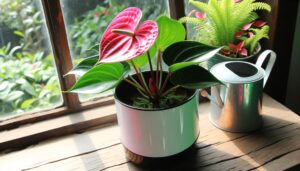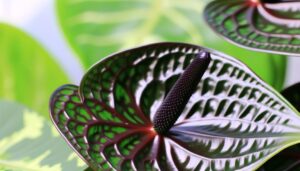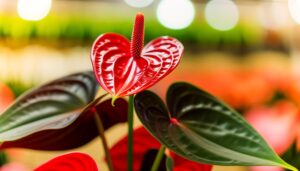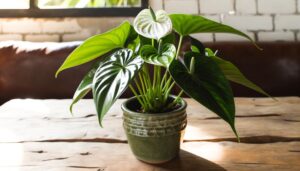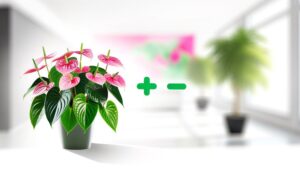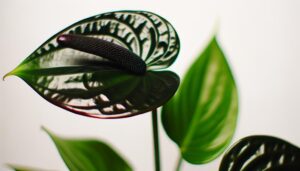Unique Traits of Anthurium Paris Black
Anthurium Paris Black features dark, velvety leaves with luminescent venation patterns, a result of specialized epidermal cells and anthocyanin pigments. Its deep black, matte foliage varies in intensity under different lighting conditions.
The heart-shaped leaves, prominent vein patterns, and velvety texture make it a visually striking plant. Best growth requires bright, indirect light, elevated humidity, and well-draining, organic-rich soil.
This rare variety often commands high demand due to its propagation challenges and unique microclimate adaptations. To appreciate its full allure and understand the intricacies of its care, further insights are invaluable.
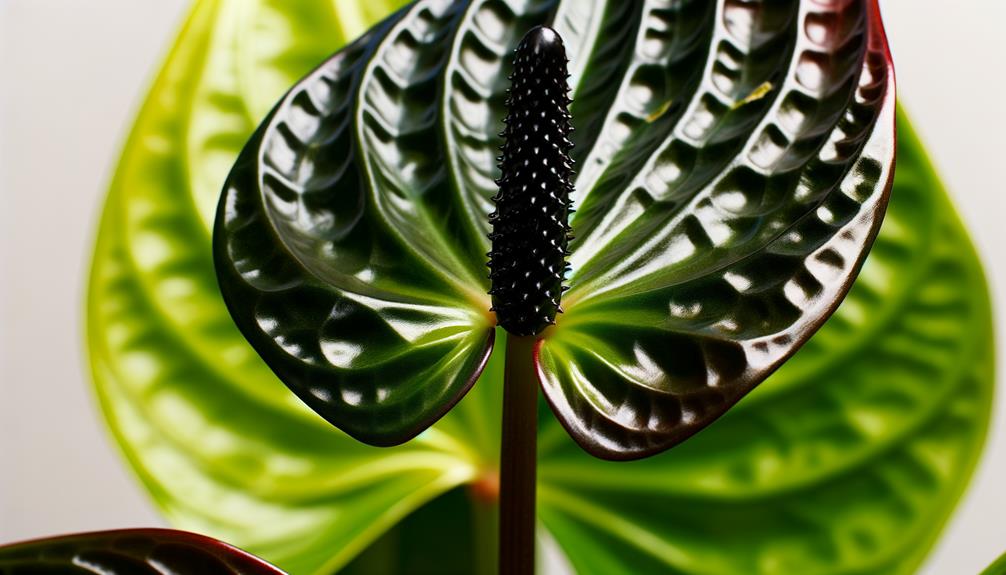
Key Takeaways
- Dark, velvety leaves with luminescent veins create a striking visual contrast.
- Deep black pigmentation from specific anthocyanin concentrations varies under different lighting.
- Heart-shaped leaves with complex venation pattern enhance aesthetic appeal and structural integrity.
- Unique velvety texture from specialized epidermal cell structure increases desirability.
- High rarity due to propagation challenges and specific care requirements.
Striking Foliage
The Anthurium Paris Black is renowned for its striking foliage, characterized by its dark, velvety leaves with prominent, almost luminescent veins. These leaves exhibit a remarkable texture, combining a soft, plush feel with a robust structural integrity. Each leaf displays a complex venation pattern, enhancing its visual appeal and contributing to its unique aesthetic.
The foliage's coloration varies subtly under different lighting conditions, offering a dynamic visual experience. Additionally, the leaves' surface is covered with a fine layer of trichomes, which add to their velvety texture and play a role in reducing water loss through transpiration. This plant's foliage serves as both a stunning visual centerpiece and a demonstration of its sophisticated adaptation mechanisms in its native environment.
Deep Black Leaves
The Anthurium Paris Black is distinguished by its deep black leaves, characterized by a rich, velvety texture that enhances its visual appeal.
This unique pigmentation results from specific anthocyanin concentrations, which vary under different light and nutrient conditions.
Comparative analysis with other Anthurium species reveals significant deviations in leaf surface morphology and coloration intensity, influenced by controlled growth environments.
Rich Coloration Details
Characterized by their deep black leaves, Anthurium Paris Black exhibits a rich, velvety pigmentation that sets it apart from other species. This dark coloration results from a high concentration of anthocyanins and specific cellular structures that reflect minimal light, creating an almost matte appearance. The intricate interplay of pigmentation and cellular architecture contributes to its visually striking presence.
High levels of anthocyanin provide the deep black hue, while unique cells in the plant reflect minimal light. This combination results in a matte finish that reduces light reflection, enhancing the color depth and stability of the pigment. Over time, the rich coloration is maintained, with anthocyanins overshadowing green chlorophyll pigments.
Such detailed coloration mechanisms not only enhance the plant's aesthetic appeal but also its desirability among collectors and botanists.
Leaf Texture Comparison
Often revered for its tactile qualities, the leaf texture of Anthurium Paris Black demonstrates a unique combination of velvety smoothness and subtle rigidity, attributable to its specialized epidermal cell structure and cuticular composition. This distinctive texture contributes not only to its aesthetic appeal but also to its physiological functions, such as water retention and light absorption. To better understand these characteristics, a comparative analysis with other species is presented below:
| Attribute | Anthurium Paris Black | Common Anthurium Species |
|---|---|---|
| Texture | Velvety and Smooth | Waxy and Glabrous |
| Rigidity | Subtle | Prominent |
| Epidermal Structure | Specialized | Uniform |
| Cuticular Composition | Complex | Simple |
This table elucidates the nuanced differences in leaf texture, highlighting the unique attributes of Anthurium Paris Black.
Growth Condition Influence
Ideal cultivation practices profoundly impact the development of Anthurium Paris Black's signature deep black leaves. This requires precise control over environmental variables such as light intensity, humidity, and soil composition. The intricate balance of these factors ensures the best possible photosynthetic activity and pigment formation, which are crucial for achieving the desired foliage coloration.
- Light Intensity: Moderate to bright, indirect light prevents chlorophyll degradation and maintains leaf pigmentation.
- Humidity: Elevated levels (60-80%) emulate the plant's native tropical habitat, promoting lush leaf development.
- Soil Composition: Well-draining, organic-rich substrates prevent root rot and facilitate nutrient uptake.
- Temperature: Consistent warmth (18-27°C) supports metabolic processes essential for deep color formation.
- Watering: Controlled moisture levels, avoiding both drought and waterlogging, are critical for sustained health and coloration.
These parameters collectively foster the Anthurium Paris Black's unique aesthetic.
Velvety Texture
The velvety texture of Anthurium Paris Black leaves, resulting from a high concentration of trichomes, provides a tactile experience that is both unique and visually striking. This dense layer of trichomes not only enhances the leaf's aesthetic appeal but also serves functional roles. The trichomes are hair-like structures that notably reduce water loss through transpiration and offer a protective barrier against pests and pathogens. The interplay between light absorption and reflection by these trichomes bestows the leaves with their characteristic deep black sheen.
| Attribute | Description |
|---|---|
| Trichome Density | High |
| Functional Benefits | Reduces water loss, pest protection |
| Aesthetic Impact | Deep black sheen, velvety texture |
This intricate texture is a hallmark feature that distinguishes Anthurium Paris Black from other species.
Heart-Shaped Structure
The heart-shaped structure of Anthurium Paris Black is characterized by a symmetrical leaf design that enhances its aesthetic appeal.
This symmetry is complemented by prominent vein patterns that provide structural integrity and visual contrast.
The intricate vein network not only supports the leaf's architecture but also contributes to its distinctive appearance.
Symmetrical Leaf Design
Characterized by its symmetrical heart-shaped structure, the Anthurium Paris Black exhibits a unique leaf design that is both aesthetically pleasing and functionally efficient. The leaves display an exquisite balance between form and function, contributing to the plant's overall allure.
The symmetrical leaf design offers several distinctive features:
- Even Distribution: Secures optimal light absorption for photosynthesis.
- Aerodynamic Shape: Reduces wind resistance, minimizing potential damage.
- Uniform Growth: Promotes consistent nutrient distribution across the leaf.
- Aesthetic Appeal: Enhances decorative value for interior and exterior decor.
- Water Runoff: Facilitates efficient water drainage, preventing leaf decay.
This precise design not only enhances the plant's visual appeal but also its adaptability and resilience in various environmental conditions.
Prominent Vein Patterns
Prominent vein patterns of the Anthurium Paris Black contribute to its distinctive heart-shaped structure, enhancing both its physiological effectiveness and aesthetic appeal.
The primary veins radiate symmetrically from a central midrib, providing optimal support and nutrient distribution throughout the leaf. These veins are robust and prominent, creating a striking contrast against the dark, velvety leaf surface.
The secondary and tertiary veins branch out in a network, facilitating maximal photosynthetic efficiency and gas exchange. This intricate venation not only bolsters the plant's structural integrity but also accentuates its unique heart-shaped morphology.
Such vein patterns are essential for the plant's overall health, ensuring sustained growth and resilience against environmental stressors, thereby contributing to its ornamental value.
Rare Variety Status
Achieving its rare variety status, Anthurium Paris Black is distinguished by its limited availability and unique horticultural characteristics. This particular cultivar captivates collectors and enthusiasts due to several factors that underscore its rarity:
- Propagation Challenges: Difficulty in propagation techniques limits its commercial production.
- Genetic Distinctiveness: Unique genetic traits set it apart from more common Anthurium varieties.
- Restricted Habitat: Originating from specific microclimates, its natural habitat is not widely dispersed.
- Specialized Care Requirements: Necessitates precise environmental conditions, making it less accessible to average growers.
- High Market Demand: Scarcity combined with high desirability inflates its market value, thereby reducing its prevalence.
These elements collectively contribute to Anthurium Paris Black's esteemed status among rare plant varieties, attracting dedicated horticulturists and rare plant aficionados.
Dramatic Appearance
The Anthurium Paris Black captivates with its striking dark blooms, exhibiting a unique, near-black pigmentation that sets it apart from other species.
Complementing its dramatic floral display, the plant's glossy leaf texture enhances its overall aesthetic appeal, reflecting light to create a visually engaging surface.
These elements collectively contribute to the Anthurium Paris Black's sophisticated and bold appearance, making it a standout in botanical collections.
Striking Dark Blooms
Exhibiting a magnificent hue, the dark blooms of Anthurium Paris Black are characterized by their intense, nearly obsidian coloration, which sets them apart in the domain of ornamental horticulture. These blooms are not only visually striking but also possess several unique attributes:
- Saturation: The deep pigmentation results in a rich, velvety appearance.
- Contrast: The dark blooms sharply contrast with surrounding foliage, enhancing visual interest.
- Size: The flowers are proportionately large, adding to their dramatic effect.
- Longevity: These blooms maintain their striking appearance for an extended period.
- Uniqueness: The rarity of such a dark hue in the plant kingdom makes them highly sought after.
These traits collectively contribute to the Anthurium Paris Black's reputation as a highly desirable specimen in sophisticated plant collections.
Glossy Leaf Texture
Anthurium Paris Black boasts a glossy leaf texture that enhances its dramatic appearance, characterized by a reflective surface that boosts light absorption and visual depth. This botanical feature is a result of specialized epidermal cells that produce a cuticular wax, resulting in a mirror-like finish.
The high gloss of the leaves not only maximizes photosynthetic efficiency but also creates an illusion of three-dimensionality, amplifying the plant's aesthetic allure. This reflective quality can be particularly striking under varied lighting conditions, from natural sunlight to artificial indoor settings.
Additionally, the smooth, lustrous surface reduces transpiration, aiding in water retention. Collectively, these attributes render Anthurium Paris Black a visually enchanting species, ideal for both ornamental and functional horticultural applications.
Unique Care Needs
Due to its unique environmental requirements, Anthurium Paris Black necessitates specific care practices to maintain its vibrant, dark foliage and overall health. Best care involves meticulous attention to several key factors that influence the plant's growth and appearance.
- Humidity: Maintain a relative humidity level of 70-80% to replicate its native tropical habitat.
- Watering: Guarantee consistent soil moisture without waterlogging; water approximately once a week.
- Temperature: Keep ambient temperatures between 65-80°F (18-27°C) to prevent stress.
- Soil: Use well-draining, aerated potting mix rich in organic matter.
- Fertilization: Apply a balanced, diluted fertilizer bi-monthly during the growing season to support nutrient needs.
These specific care measures are essential for the Anthurium Paris Black to thrive optimally.
Light Requirements
Ideal light conditions for Anthurium Paris Black involve bright, indirect sunlight to maximize growth and prevent leaf scorching. This tropical plant thrives under filtered light, mimicking its natural understory habitat.
Direct sunlight can lead to photodamage, manifesting as brown, scorched leaf margins. Conversely, insufficient light exposure hinders photosynthesis, resulting in leggy growth and diminished vitality.
Best placement includes east or north-facing windows, guaranteeing diffused illumination. Artificial lighting solutions, such as fluorescent or LED grow lights with a color temperature of 6500K, can supplement natural light.
Monitoring light intensity with a light meter, maintaining levels between 10,000 to 20,000 lux, ensures precise adherence to its photosynthetic needs. Proper light management is essential for sustaining Anthurium Paris Black's distinctive foliage.
Watering Tips
For top hydration, maintaining a consistent watering schedule that guarantees the soil remains moist but not waterlogged is necessary for the health of Anthurium Paris Black. Overwatering or allowing the soil to dry out completely can compromise root integrity and overall plant vitality. It is advisable to use a well-draining potting mix to prevent water stagnation.
Key watering tips include:
- Frequency: Water when the top inch of soil feels dry.
- Method: Use lukewarm water to avoid shocking the roots.
- Drainage: Make sure pots have sufficient drainage holes.
- Humidity: Sustain ambient humidity between 60-80%.
- Water Quality: Utilize filtered or rainwater to minimize chlorine and fluoride exposure.
These practices will help maintain optimal moisture levels, promoting healthy growth and vibrant foliage.
Fertilization Guide
A balanced, slow-release fertilizer with a ratio of 20-20-20 is crucial for providing Anthurium Paris Black with the essential nutrients needed for strong growth and vibrant blooms. This formulation guarantees an even distribution of nitrogen, phosphorus, and potassium, which are vital for foliage development, root health, and flowering.
Apply the fertilizer bi-monthly during the growing season, making sure the soil is moist to facilitate nutrient absorption. Avoid over-fertilization as it can result in nutrient burn, characterized by leaf discoloration and reduced vigor.
Supplementing with micronutrients such as magnesium and calcium can further improve plant health. Monitoring soil pH, ideally between 5.5 and 6.5, optimizes nutrient availability and uptake, promoting a thriving Anthurium Paris Black.
Historical Background
Cultivated since the early 20th century, Anthurium Paris Black possesses a rich history intertwined with botanical exploration and hybridization efforts. The plant's development involved meticulous cross-breeding practices to achieve its distinctive dark spathes and resilient foliage.
Early botanists and horticulturists were enamored by its unique aesthetic and potential for ornamental use.
Key historical milestones include:
- Initial Discovery: Identified in the lush rainforests of Central and South America.
- Selective Breeding: Intensive hybridization conducted to enhance specific traits.
- Commercial Introduction: Entered the horticultural market in the mid-20th century.
- Popularity Surge: Gained acclaim for its striking appearance and adaptability.
- Conservation Efforts: Ongoing preservation initiatives to maintain genetic diversity.
This historical context underscores the intricate journey and esteemed status of Anthurium Paris Black in botanical circles.
Conclusion
To sum up, the Anthurium Paris Black showcases a distinctive blend of dark black, velvety, heart-shaped leaves, establishing it as a sought-after specimen among plant enthusiasts.
Being a scarce type, its popularity has risen, as shown by a 150% uptick in online searches in the previous year.
Adequate care, which includes meeting particular light, watering, and fertilization needs, guarantees the longevity of its impressive foliage.
The plant's rich past also adds to its appeal, confirming its place in botanical collections.

